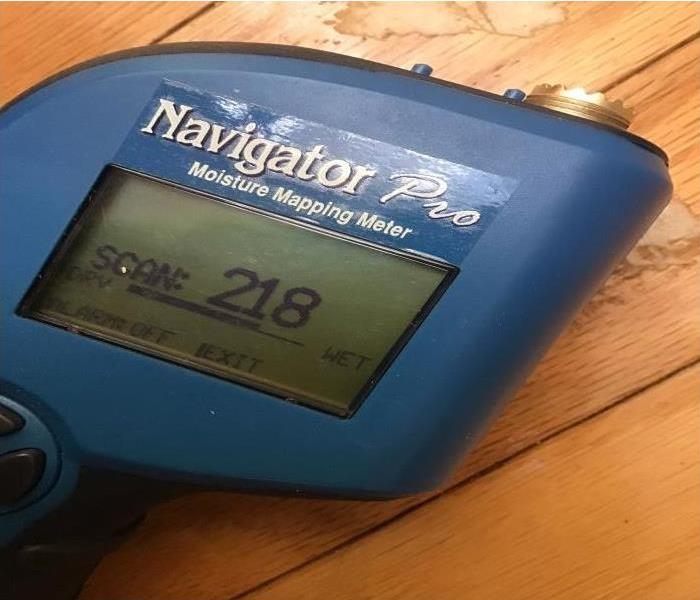Moisture in Your Home
5/27/2020 (Permalink)
1) – Your home produces moisture.
Any household produces moisture by cooking, washing, bathing and exercising. Even breathing brings moisture into the air. Your family and pets bring many liters of water into your home every day. Moisture can also enter your house from the soil through the basement or crawl space.
2) – High humidity is not healthy
Humidity is important for our health. A normal humidity level is needed for feeling comfortable. However, too much moisture in your home can cause big problems and even affect your health. Microorganisms that thrive in humid conditions are of special concern as they can help cause allergies and asthmatic conditions.
3) - Low humidity is not healthy either
Low humidity can, in turn, have all kinds of unpleasant effects. Your skin can feel dry, your lips can start to chap and your eyes can start to itch. Sore eyes, difficulty breathing and painful sinuses are also common problems caused by too dry air. This is especially true in winter when the outside air tends to be very dry. Air conditioned spaces, including airplanes and offices, are also well known ‘dry zones.’
4) – Bugs and mold love a humid home
Bugs thrive in humid conditions. Dust mites especially love warm temperatures (23-27 degrees Celsius / 75-80 degrees Fahrenheit) and high humidity levels of 70-80%. One study has found that mite populations stop growing and die out when relative humidity levels drop below 60%. Air conditioning has been proven to lower dust mite allergens in homes by lowering the ambient temperature and relative humidity. Mold loves humid conditions as well. When the relative humidity is higher than 80%, mold is likely to develop more than 50% of the time. Their spores are known to contribute to the development of asthma in children and cause allergies.
5) – Moisture is the No. 1 electronics killer
Excess moisture can not only damage your health, but also damage your possessions. Electronics are especially susceptible to damage by condensation. Moisture can corrode contacts inside and lower insulation resistance, which may cause short circuits. Watch for high humidity and drastic temperature changes that occur when bringing in electric appliances from your cold garage or basement. Take care to let them adjust to the climate before switching them on. You can protect stored electronics or other valuables by putting them in closed plastic boxes with a small dehumidifying satchel/bag.
6) – Winter is the real humid season for homes
The air is often cold and dry in the winter. While your lips, skin and nails suffer due to all that winter dryness, your house might suffer from the effects of excess moisture because two things happen:
Winter is the heating season. We close our windows and reduce ventilation and circulation of air in our homes to keep out the cold. At the same time, rain and melting snow can increase the amount of moisture entering your house through crawl spaces, basements and walls. Because less moisture leaves the house, humidity levels inside can start to rise.
At the same time, something else happens. Parts of your house that are in direct contact with the cold outside air are cooler than the air inside. Examples are single glazed windows and walls with low insulation. The temperature difference with the warm, moist air inside can cause continuous condensation to occur on those cold surfaces. All that wetness will attract mold growth and cause moisture stains.
7) – Ventilation is essential
Especially areas that produce a lot of moisture like bathrooms, kitchens and bedrooms need lots of ventilation. In some areas, it is simply not possible, cost effective or energy efficient to ventilate continuously. For those areas, there are many great solutions out there. Check our dehumidifier section for suggestions.
8) – Humidity is always relative
So what exactly is “humidity,” anyway? Humidity is the amount of moisture or water vapor in the air. However, you will usually hear the term “relative humidity.” Why “relative”? Because the maximum amount of water the air can “hold” depends on the temperature of the air. A relative humidity of 100% means the air contains the maximum amount of water it can hold at that specific temperature. Warmer air can hold more water than colder air.
So, what happens when warm humid air cools down? The colder air can hold less moisture and might “drop” some of it. This happens most easily when warm, humid air comes into contact with a cold surface (like a cool soda bottle in summer or windows in winter). Water released by the air in this way is called “condensation,” which can cause serious problems in your home, car, boat or RV.
9) – The ideal humidity level is 40-60%
Opinions on the ideal relative humidity level in your home vary somewhat. Generally, it is thought best to be in the 40-60% range. Moving outside this range for a short period is not likely to cause you any discomfort. Negative effects are most likely to occur when parts of your home are continuously exposed to high humidity.
10) – Humidity can be controlled
There are many solutions available to help you maintain healthy humidity levels and moisture problems. You can use a hydrometer to monitor the inside air and there are all kinds of commercial dehumidifiers and humidifiers out there. They all have their advantages and disadvantages.
If you require help with any moisture issues in your home, please call SERVPRO of Allston, Brighton & Brookline (617) 903-5055






 24/7 Emergency Service
24/7 Emergency Service
